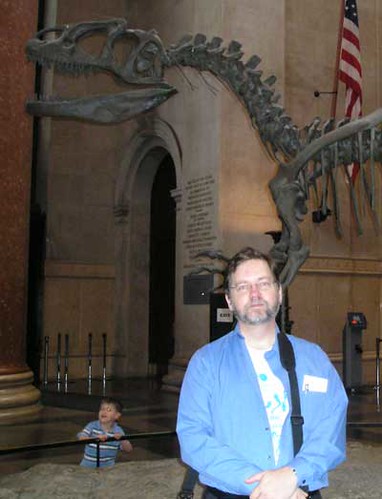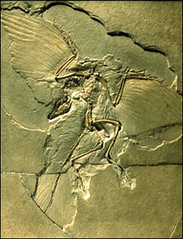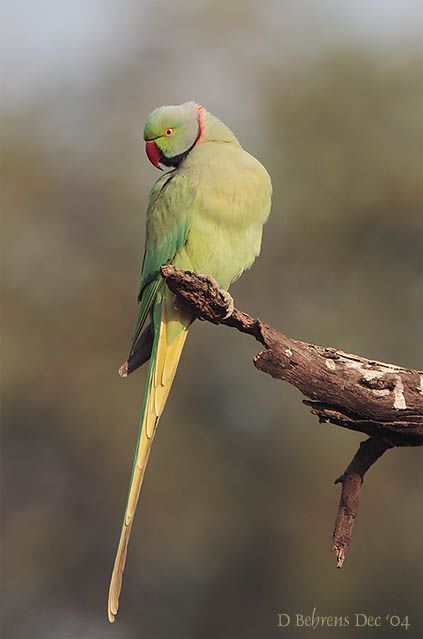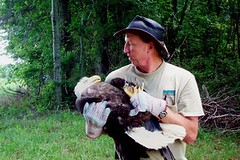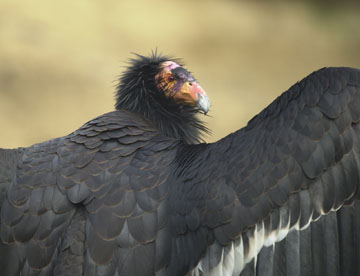
Found: rare albino turkey vulture, Cathartes aura.
This individual was photographed in the Florida keys. (story below)Enemies of All Birds Award, 2005: Although there are many contenders worldwide for this award, this is the first of two stories that will share my 2005 "Enemy of All Birds" award for the most loathsome display of cruelty, ruthlessness and detestable disdain for the life of birds. It is my sincerest desire that all of the winners of this award receive a mandatory bout of influenza, complete with explosive diarrhea, in the hopes that this would cure these trappers, smugglers and so-called "gourmands."
Even though almost nine out of ten (88 per cent) of Cypriots say they
disapprove of illegal trapping of migrating songbirds to be served as expensive delicacies in local restaurants, half those polled had tried “ambelopoulia”, as the dish is called, and 14 percent said it was their favourite bird dish. In 2000, BirdLife Cyprus estimated more than 12.6 migratory million birds were trapped each year.
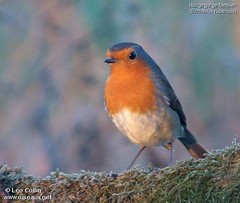
The blackcap,
Sylvia atricapilla, and the European robin,
Erithacus rubecula (pictured), are the most common targets, but research shows over 100 species are regularly killed, including 42 which have unfavourable conservation status in Europe. Two are Cypriot endemics, the Cyprus Warbler,
Sylvia melanothorax, and the Cyprus wheatear,
Oenanthe cypriaca. Even worse, the indiscriminate use of mist-nets and lime twigs results in so-called “by-catch” of unsaleable birds, such as Long-eared Owls,
Asio otus, and globally threatened lesser kestrels,
Falco naumanni. Trapping songbirds has been illegal in Cyprus for more than 30 years, but fines are low compared to money that is made by supplying restaurants, where birds can sell for two pounds (US $3.58) or more
each. Once a way of supplementing a family’s subsistence diet by setting out a few limed twigs, trapping now uses mist nets, recordings of songs and calls, and groves of trees deliberately planted to attract migrating birds looking for water and shelter. A campaigner with the RSPB, investigating one such grove in 2004, found poles for mist nets permanently embedded in concrete bases.
Speaking of eating everything in sight, this story tells of a recent crackdown on the Indo-Nepal border that has exposed a
parrot smuggling racket, with the Bahraich police seizing about 2,000 birds that were trapped from the Kartaniya Ghat Sanctuary. The parrots, belonging to the Rodrigue(z?) parakeet family, were reportedly being taken to Nepal, where they are said to be a favoured delicacy
especially among foreign tourists. Some of the birds are even sent to China from there. ‘‘[Y]es, parrot meat is liked by the Chinese and many other countries,’’ said State Chief Wildlife Warden Mohammad Ehsan. Parrot smuggling is said to be a lucrative business, with the local Indian catcher getting Rs 100-300 per bird. In Nepal, the cost goes up to an unbelievable US $500 for 10 parrots.
MORE People Hurting Birds:Competing with the twin evils listed above for the 2005 "Enemy of All Birds" award is the island of Malta, which is
doing its part to decimate the last remnants of wild European migratory birds, too. BirdLife Malta says that they hear regular reports of illegal hunting of marsh harriers,
Circus aerunginosus, falcons, grey and night-herons, little egrets,
Egretta garzetta, hoopoes,
Upupa epops, bee-eaters and other species as bird migration goes into full swing. In a letter sent to Deputy Prime Minister Tonio Borg, BirdLife Malta complained of the poor state of law enforcement of the bird protection laws. In the letter, BirdLife Malta points to continuous illegal hunting reports during both the closed and the open hunting season. "With this level of law enforcement a massacre is inevitable if a major influx of birds of prey occurs."
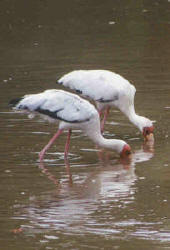
Not only is the widespread destruction of mangrove forests causing trouble for people (remember the Indonesian tsunami that occurred the day after Christmas, 2004? Its effects were
greatly magnified because of mangrove destruction so people can farm shrimps to feed rich Westerners), but this loss of mangrove habitat is also
causing the extinction of birds and animals. In this case, the milky storks,
Mycteria cinerea (pictured), are facing extinction, according to the Malaysian Nature Society (MNS). There are only 10 wild storks in all of Malaysia, all of which are located at the Matang Mangrove Forest Reserve in Perak. "It would be no surprise if the milky stork is
extinct in Malaysia in the next five years," said MNS scientific officer of Ornithology, Yeap Chin Aik, at a birdwatching seminar at Kolej Ugama Sultan Zainal Abidin. Human disturbance of nesting colonies, mangrove habitat destruction and poaching decimated these storks.
People Helping Birds:Whew, after those previous two sections, I am taking a breather by telling you about
some people's capacity for humanity and decency. An
ambitious project to persuade the highly endangered Bermuda Petrel,
Pterodroma cahow, to move to safer alternative sites is showing early signs of success. More remarkable than even the ivory-billed woodpecker because they were believed to be extinct for almost 300 years, numbers of Bermuda Petrels, known locally as "Cahows", have been slowly recovering since the species was rediscovered in 1951, when just 18 pairs were known. In 2003, these birds managed to survive the wrath of Hurricane Fabian because they were out at sea when it struck, but the birds later returned to their breeding burrows to discover they had been destroyed by the storm. In 2004, Bermuda’s Department of Conservation, with the help of the New South Wales Department of Parks and Wildlife, began a translocation program, moving 14 chicks to a complex of artificial burrows on nearby Nonsuch Island. This island is larger and higher, and offers much greater potential for growth for the Cahow population. Officials also managed to exclude rats and other predators and to restore the endemic forest cover on this island so it now closely resembles the original nesting habitat as described by early settlers. "We have also been successful in attracting Cahows to nest in an entirely new complex of nest burrows built on the most elevated section of the largest present nesting islet," said Jeremy Madeiros of Bermuda’s Department of Conservation Services. "We were rewarded with three pairs occupying and building nests in the new burrows. One pair were identified from their band numbers as birds which had been physically moved to the new burrows, so the combination of techniques seem to have worked."
Who says that New Yorkers don't care about nature and birds? The city that never sleeps
will darken the lights of the famed Manhattan skyline after midnight to help save migrating birds. This past Tuesday, New York civic leaders said the lights of buildings above the 40th floor will be turned off after midnight in the fall and spring migration seasons to save bird lives. "New York City is this nexus of ancient migratory flyways, and the parks have become these havens for these birds, but ... the buildings with their light draw birds to them, sort of like moths to a flame," NYC Audubon Director E.J. McAdams said at a news conference. Since 1997, more than 4,000 migratory birds have been killed or injured from colliding into skyscrapers, bird experts say.
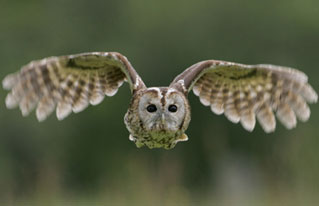
The
tawny owl, Strix aluco (pictured), is the most common of the five owl species in Britain and is the one most likely to be heard in woodland or suburban areas. However, fears are growing for the plight of this bird whose eerie call was once a familiar sound across East Anglia. The Norfolk-based British Trust for Ornithology estimates that tawny owl numbers have dropped nationally by more than 30% in the past 10 years. It is asking for
volunteers to donate 20 minutes per week to help estimate numbers of birds and where they live and has set up a special "owlaphone" with recordings of calls to help people recognise a tawny owl cry. You can also
listen to a streaming news story about this project (story contains a clickable link to a ram file, 0.2 Kb).
Two members of the National Trust Parrot Monitoring Programme in the Cayman Islands, Jenny Nickolov and Marnie Laing, had the bright idea of
helping the national bird population, especially the endangered Grand Cayman parrot,
Amazona leucocephala caymanensis, recover after Hurricane Ivan, by selling T-shirts featuring the island's endangered birds. Money from the T-shirts will be used to provide bird houses and bird feeders. The houses and feeders will be placed around Grand Cayman, and are intended to help the parrots, who have lost so much of their natural habitat and feeding territory. In addition to the parrots, it is hoped that the program will provide help for other indigenous birds such as thick-billed vireos,
Vireo crassirostris, Cuban bullfinches,
Melopyrrha nigra, Caribbean doves,
Leptotila jamaicensis, and West Indian woodpeckers,
Melanerpes superciliaris.
Birds Flu News:After two children were hospitalized with suspected "bird flu", Indonesia went on
high alert over the Avian Influenza threat. Adding to fears among the general population in Jakarta, Indonesia's capital city,
authorities closed the city's main zoo after tests showed
some exotic birds had been infected with avian flu. "It's a high alert. Every region is on alert so if at any time it occurs in remote areas, we are ready," Health Minister Siti Fadillah Supari told reporters, adding the government had not declared a state of emergency. The highly pathogenic H5N1 strain of the Avian Influenza virus has killed four Indonesians, including one woman who died in Jakarta a week ago. The virus has killed 64 people in four Asian countries since late 2003 and has also spread to Russia and Europe. Officials noted that the cash-strapped government had little money to carry out a mass culling of infected poultry or birds.
High-Tech Birds:Have you heard
BirdNote yet? No?? Well, what are you waiting for? Featured this week on the popular radio show, BirdNote; a discussion of collective nouns,
A Murder, a Party, a Stare, or a Siege; diving and dabbling ducks; stories about HawkWatch in Washington State and in Veracruz, Mexico; and on Friday, something completely different, "Twitiavis Superciliosis," written by KPLU radio blues guru, John Kessler. Click
here to access this week's schedule and photographs. BirdNote shows are two-minute vignettes that incorporate the rich sounds of birds with stories that illustrate the interesting -- and in some cases, truly amazing -- abilities of birds. BirdNote can be heard Monday through Friday, 8:58-9:00AM, throughout Western Washington and Southwest British Columbia and is also available as RSS/Podcast feeds.
Bird-watching hadn't changed much in the last century, until recently. A flock of
new technologies is swooping into hobbyists' quiet preserve. This story discusses many of the recent innovations that are available to birders.
Miscellaneous Birds:Is it possible to be both male and female at the same time? Well, yes it is, although this is often easier to diagnose in birds that show sexually-dichromatic plumage than it is in monomorphic birds and animals. Animals where part of the body is genetically male and part of the body is genetically female are known as "gynandromorphs". In this linked essay, you will see amazing photographs of a
nearly perfect bilateral gynandromorph Rose-breasted Grosbeak,
Pheucticus ludovicianus, that was recently banded by Powdermill Bird Banding Lab (scroll down on linked page).
Speaking of banding wild birds (or "ringing" as it is referred to in Europe), banding teaches us many things about birds and how they live, as discussed in
this article.
Would you like to take an online
Birds of Prey Quiz? GrrlScientist note:
I guess it goes without saying that I got 100%.Recently, an
albino turkey vulture,
Cathartes aura, was spotted by birders in Heron Lake State Park in New Mexico. [The bird pictured at top may or may not be the same individual. It is unclear if the bird in the photo is the NM bird because turkey vultures move around a lot]. GrrlScientist note:
I hope someone gets a picture of the bird before it moves on (or before some bonehead shoots it).Not really a bird, but this is the nearest thing to feathers that evolved among mammals! Firefly Forest Blog, located in Arizona state, shares some fascinating pictures of
noctural mammals feeding at a hummingbird feeder.
Thanks to bird pals, Ellen, Dawn, Jim, and Ron for some of the links that you are reading here.tags: Birds in the News, ornithology, birds, avian, newsletter
Previous : : Birds in the News : : Next

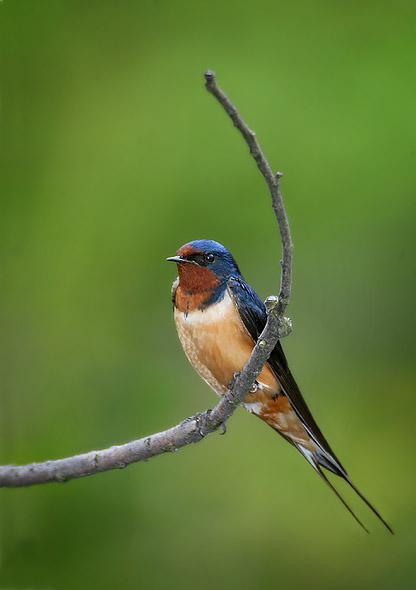
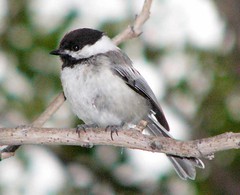 Who would have guessed that when a chickadee opens its tiny beak, it has a lot to say? Biologists studying the
Who would have guessed that when a chickadee opens its tiny beak, it has a lot to say? Biologists studying the 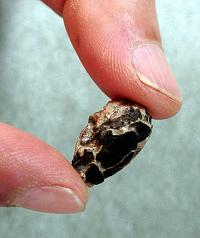 Scientists say they have found
Scientists say they have found 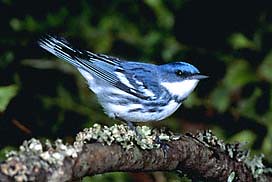 Fundacion ProAves and the American Bird Conservancy (ABC) announced the purchase of land in the South American country, Colombia, to protect a migratory songbird, the
Fundacion ProAves and the American Bird Conservancy (ABC) announced the purchase of land in the South American country, Colombia, to protect a migratory songbird, the 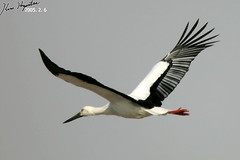
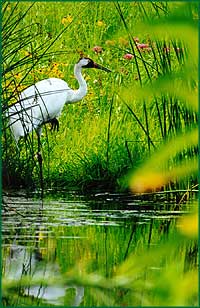 Finally (!), a legal judgement will be handed down for the
Finally (!), a legal judgement will be handed down for the 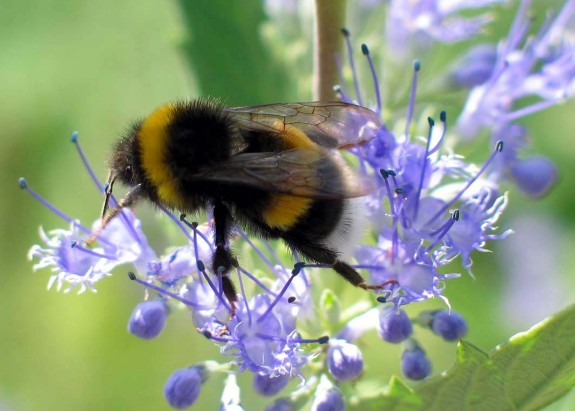
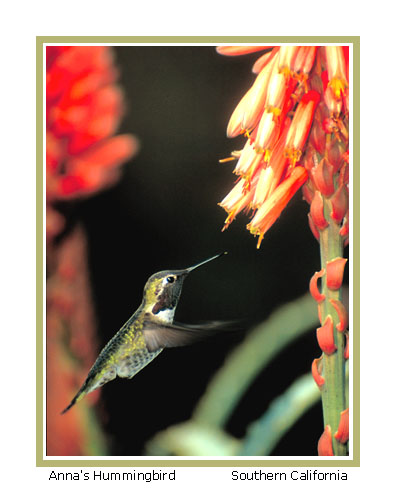

 The blackcap, Sylvia atricapilla, and the European robin, Erithacus rubecula (pictured), are the most common targets, but research shows over 100 species are regularly killed, including 42 which have unfavourable conservation status in Europe. Two are Cypriot endemics, the Cyprus Warbler, Sylvia melanothorax, and the Cyprus wheatear, Oenanthe cypriaca. Even worse, the indiscriminate use of mist-nets and lime twigs results in so-called “by-catch” of unsaleable birds, such as Long-eared Owls, Asio otus, and globally threatened lesser kestrels, Falco naumanni. Trapping songbirds has been illegal in Cyprus for more than 30 years, but fines are low compared to money that is made by supplying restaurants, where birds can sell for two pounds (US $3.58) or more each. Once a way of supplementing a family’s subsistence diet by setting out a few limed twigs, trapping now uses mist nets, recordings of songs and calls, and groves of trees deliberately planted to attract migrating birds looking for water and shelter. A campaigner with the RSPB, investigating one such grove in 2004, found poles for mist nets permanently embedded in concrete bases.
The blackcap, Sylvia atricapilla, and the European robin, Erithacus rubecula (pictured), are the most common targets, but research shows over 100 species are regularly killed, including 42 which have unfavourable conservation status in Europe. Two are Cypriot endemics, the Cyprus Warbler, Sylvia melanothorax, and the Cyprus wheatear, Oenanthe cypriaca. Even worse, the indiscriminate use of mist-nets and lime twigs results in so-called “by-catch” of unsaleable birds, such as Long-eared Owls, Asio otus, and globally threatened lesser kestrels, Falco naumanni. Trapping songbirds has been illegal in Cyprus for more than 30 years, but fines are low compared to money that is made by supplying restaurants, where birds can sell for two pounds (US $3.58) or more each. Once a way of supplementing a family’s subsistence diet by setting out a few limed twigs, trapping now uses mist nets, recordings of songs and calls, and groves of trees deliberately planted to attract migrating birds looking for water and shelter. A campaigner with the RSPB, investigating one such grove in 2004, found poles for mist nets permanently embedded in concrete bases.  Not only is the widespread destruction of mangrove forests causing trouble for people (remember the Indonesian tsunami that occurred the day after Christmas, 2004? Its effects were
Not only is the widespread destruction of mangrove forests causing trouble for people (remember the Indonesian tsunami that occurred the day after Christmas, 2004? Its effects were  The
The 